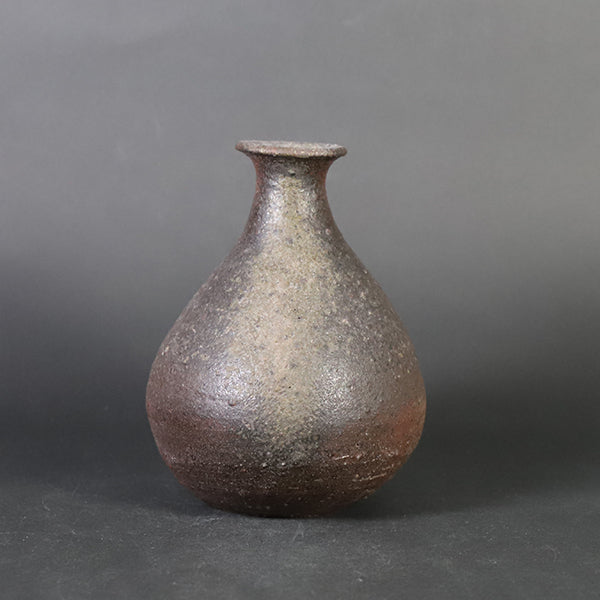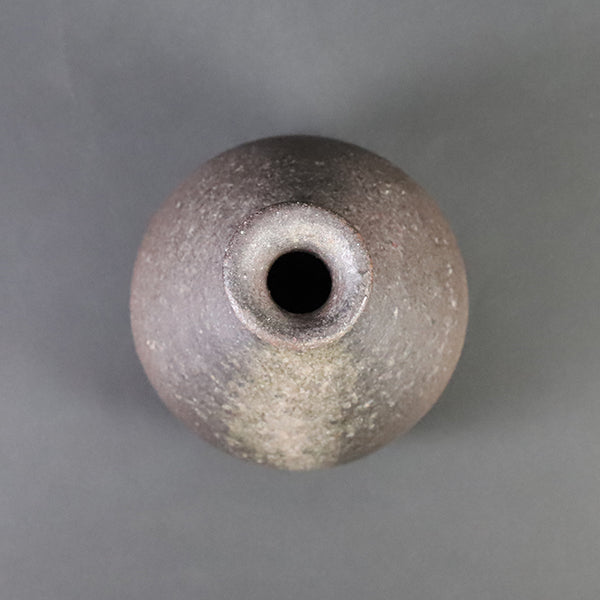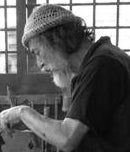Takashi NakazatoTakashi Nakazato
-
ギャラリー一番館
からのご紹介 - 陶歴・プロフィール
-
Following the recommendation of ceramics researcher Fujio Koyama, Takashi traveled to Tanegashima and began making Yakishime and Tanegashima ware. After returning to his hometown, the artist continued to make his own unique Yakishime style "Karatsu Nanban" using soil rich in iron, and in recent years has traveled around the world, including the United States, Germany, Italy, and Chile, making pottery that makes the most of the environment he experiences. Takashi, the fifth son of Living National Treasure Muan Nakazato, trained in Kyoto and Arita before moving to his family's Nakazato Tarouemon Kiln, where he turned out several hundred dishes a day and contributed to the golden age of the Nakazato Tarouemon Kiln together with his father Muan and his two older brothers, Hoan and Shigetoshi.
The Creation of Karatsu Nanban and Representative Works and Techniques
When Fujio Koyama, a ceramics researcher, was looking for someone to revive Nono ware in Tanegashima, he chose Muan's son Takashi. Nono ware was a primitive form of pottery made by mixing the clay and ash glaze, but by taking advantage of the iron-rich soil of Tanegashima, Takashi began to make "Tanegashima ware" using a Yakishime technique. After returning to Karatsu after three years of pottery making in Tanegashima, he continued to focus on simple Yakishime pottery and created a new Karatsu ware style called "Karatsu Nanban".
Representative pieces include traditional E-Karatsu pieces, Kohiki, Mishima, Hakeme, etc. In recent years, a firing method called cooling reduction has been used, which makes it possible to produce a unique glossy finish, almost like a silvered surface, compared to traditional Karatsu ware, and the design and texture of the pottery are designed to fit modern life.A food-conscious writer
Nakazato Takashi is a writer who is very particular about food, and he buys fish himself in the morning and holds his knife. He has produced quite a few sushi restaurants, and in many restaurants, there are rows of dishes with his signature engraved on the side of the high base, with the characters "shu" and "u".
Tokkuri and katakuchi are tools used to pour sake, but when sake is poured, it does not drip from the mouth. Ryusaku's tokkuri and katakuchi are famous for their sharp mouths, and after firing they are tested with water to ensure that not even a single drop drips. Ryusaku himself is particular about the mouth of each piece, saying that it is the mouth that determines the overall look of the vessel, and he pays great attention to the mouth making in the final stage of molding. Many of the same type of works vary in diameter and height, which at first glance makes it seem as if they were carefully made, but the sense of balance in such small details is exquisite, and each and every piece of vessel has an overwhelming atmosphere.



Pottery making abroad
He spends half the year abroad, and continues to create pottery in America and various European countries. For example, the jagged pattern carved into his plate was made using a pizza cutter that he happened to come across in town during a visit to Germany. By combining his innovative use of tools, clay, and glazes with Nakazato Takashi's sense of form, he is constantly producing new pottery, and although he holds numerous solo exhibitions throughout the year, each one leaves a fresh impression. He always has a new sensibility, which continues to evolve.
Perhaps it is only natural that we, living in a modern world filled with gorgeous and extravagant things, would seek out Takashi Nakazato's pottery, which is made to blend into the space without any unnecessary elements. His pottery shines more with continued use, and will continue to fascinate those with a high level of aesthetic sense without ever becoming tired of it.


-
【profile】
Born: 1937
Pottery Ryuta Kiln
Hobby: Baroque music
[Ceramics history]
1937 Born in Karatsu as the fifth son of Living National Treasure Nakazato Muan
1961 Won first place at the 10th Contemporary Japanese Ceramic Art Exhibition for the ceramic sculpture "Two Fishes"
1967 Traveled around the world for a year
1971 Established a kiln in Tanegashima on the recommendation of Fujio Koyama
In September, he held his first solo exhibition of Tanegashima ware at Mitsukoshi Department Store in Nihonbashi and Takashimaya Department Store in Osaka.
1974 Returned to Karatsu and built a kiln in Mikari, Karatsu City
Named Ryuta Kiln by Fujio Koyama
Currently, he is based in Karatsu and Colorado (USA) and is also active in Denmark and other countries.
Currently producing all over the world















